Cochineal is another of the dyes I received from the Guild and used at the workshop a while back. In fact, there was a choice of cochineals. In what I realise now was my ignorance, I chose ‘carmine cochineal’ because it was ground up and I was unsure how I could adequately grind the whole dried insects I also have. As you can see, after an initial period of being dull ornage, the dye bath was an impressively shocking pink. It turns out that ‘carmine cochineal’ is not a shade of cochineal but a preparation of cochineal boiled with ammonia or sodium carbonate. I borrowed Frederick Gerber’s Cochineal and the Insect Dyes 1978 from, the Guild and found that the deeper red colour I had in mind when I saw the term ‘carmine’ could only be obtained from this preparation with the application of a tin mordant which I am not prepared to use. the colours we achieved with alum were well within the range indicated by the included colour chart of wool samples (those were the days!)

The colour range on this card (with madder beneath for comparison) is impressive even without tin.
We dyed organic wool. I dyed silk paj and twined string (the orange string was dyed with madder).
I brought the vat home with me and dyed a lot more fibre in an attempt to exhaust it. Here is grey corriedale mordanted with alum and overdyed with carmine cochineal.
And spun–three plied. This is my first ever crocus flower, by the way!
The magenta silk embroidery thread had maximum time in the bath, since I fished it out when removing the dyestuff (in its recycled stocking) prior to disposing of the bath!

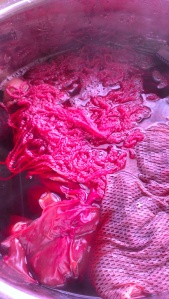
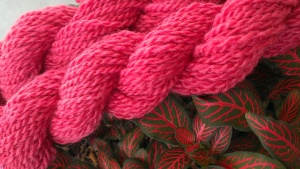
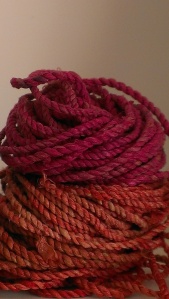
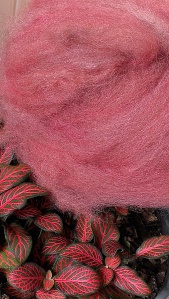
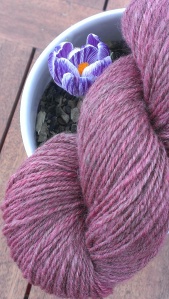
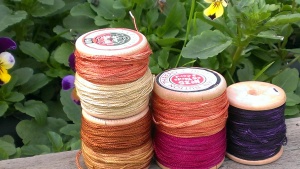
I grind my bugs in the coffee grinder 🙂
I used to get a nice red from cochineal, with just using alum. The bugs I used were over 30 years old, given to me by a friend who had brought them back with her after traveling in Mexico learning natural dyeing and weaving.
My more recent attempts, with newer bugs, have given me more of a blueish red.
Cochineal is VERY ph sensitive. I would play around with that in mind.
Love all of your results!
LikeLike
I don’t own a coffee grinder, but that does seem like a good solution. Now I’ve tried it once… ready for future adventures in Ph 🙂 Thanks for the tip!
LikeLike
I think it’s interesting that it was treated with ammonia, from what I remember I got much better colour adding acid to the dye bath!
LikeLike
Yes, acidic additives do seem to be the main Ph variations, based on what I’ve read…
LikeLike
Who can resist cochineal, what a colour, what variety of hues!!! Wonderful.
LikeLike
I’ve never tried it before, and have to agree! You can understand why it was such a massive trade–so much colour relative to dyestuff!
LikeLike
I forgot to mention – I use pepper grinder to grind cochineal. And alum with cream of tartar as mordant. I like the colour with rhubarb root mordant here.
LikeLike
I like the colour with rhubarb too, and this is one of the few dyes to appear to have bonded with the rhubarb. A pepper grinder is a great idea–and one I could access, so thanks for the tip–I hadn’t thought of that as an option. And with your thoughts and Gerber’s colour chart–it seems clear this is a place where CoT makes a difference. I am often unsure whether it does and so use it rather sporadically. Many thanks!
LikeLike
I learned about Cot as a must for dyeing wool from Michel Garcia’s DVD. I know it’s generally used less and less by nat dyers (some abundant even alum) but he explains that COT ensures even absorption of alum by wool – among other things.
LikeLike
That’s interesting–because I also have seen the dvd and his explanation was the first time I thought I understood what the point of using CoT was, as opposed to taking it on faith. And as you can tell, I don’t run far on faith!
LikeLike
we got the most wonderful deep red with madder at the Michel Garcia workshop by co-mordanting with gall nut extract (10%) and 10% citric acid on wool. a medieval sort of red rather than the primary colour, a touch of red brick to it. what is CoT?
LikeLike
Madder is such a great plant! CoT is cream of tartar.
LikeLike